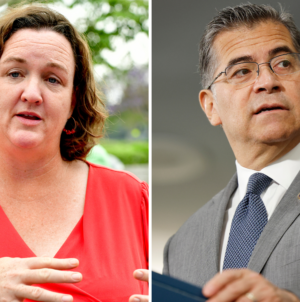-
California Governor Race: Leading Candidates as Kamala Harris Opts Out - 6 mins ago
-
A dozen Democrats sue ICE for preventing detention center oversight visits - 10 mins ago
-
U.S. Hits Brazil With 50% Tariffs and Sanctions in Sharp Escalation - 24 mins ago
-
Ferrari F1 Leadership Talks Heating Up as Vasseur’s Future Stays Undecided - 40 mins ago
-
Kamala Harris move leaves one door open while closing another - 51 mins ago
-
Brown University Makes a Deal With the White House to Restore Funding - about 1 hour ago
-
Hysterics as Woman Comes Home to Find Dog Locked in Crate—Along With a Note - about 1 hour ago
-
L.A. City Council bans N-word and C-word at meetings - 2 hours ago
-
Dodgers Reportedly Calling On Twins Relievers As Deadline Looms - 2 hours ago
-
Kamala Harris Will Not Run for California Governor in 2026 - 2 hours ago
Tsunami warning upgraded for California coast after Russian earthquake

A tsunami advisory was issued for all of the California coast after an 8.8 magnitude earthquake struck off the eastern coast of Russia, sending powerful waves slamming into buildings in Siberia and northeastern Japan.
According to the U.S. Tsunami Warning Center, the advisory was in effect for the entire West Coast, including Washington and Oregon, as well as portions of British Columbia and Alaska. A more severe tsunami warning is in effect in Hawaii, Guam, and the western section of Alaska’s Aleutian Islands, where residents have been urged to immediately evacuate coastal areas.
A tsunami advisory is the middle level of the U.S. Tsunami Warning Center three-tier alert system — watch, advisory and warning — and means that strong currents and dangerous waves are expected and that people should stay off of beaches. Should a tsunami materialize in California, it would hit the Mendocino County coast at 11:50 p.m. and reach the Los Angeles area by 1 a.m., according to the warning center.
Where are California’s tsunami hazard zones?
Tsunami hazard zones can extend to bayside and riverside areas relatively far from the Pacific coast.
Zoom in and move the map to see the state’s tsunami hazard areas
The largest impact is expected in Crescent City in Del Norte County, where waves of up to 5.4 feet are predicted. Crescent City’s harbor was destroyed and one man died in a 2011 tsunami, which was generated from a 9.1 magnitude earthquake off the east coast of Japan.
Waves of up to 3.8 feet are predicted in Port San Luis in San Luis Obispo County. The rest of the California coast is to predicted see waves of 1.4 feet or less, with waves in Los Angeles expected to be less than 1 foot.
The earthquake struck off of the eastern coast of Russia’s Kamchatka Peninsula in eastern Siberia at 9:25 a.m. Wednesday local Russian time — which is 4:25 p.m. Tuesday PDT — generating strong tremors that injured several people, according to reporting by Reuters.
A tsunami of 10 to 13 feet hit the Kamchatka Peninsula in Siberia within hours of the earthquake, damaging buildings, including a kindergarten, according to Reuters. Japanese officials advised people to evacuate tsunami-prone areas along the country’s east coast, warning that waves of up to 10 feet could strike the coastline.
Hawaii News Now reported congested roadways as people heeded evacuation plans, and some were seen stocking up at Costco ahead of the expected arrival of the tsunami, which could come as early as 7:17 p.m. local time, or 10:17 p.m. PDT.
One of the first tsunami reports came in Hokkaido, Japan, where the Nemuro Hanasaki port experienced a 1-foot tsunami, according to NHK, the Japanese broadcaster. NHK footage showed buildings that appeared to be warehouses being swept away by strong tsunami currents in northeastern Japan.
The U.S. Tsunami Warning Center had initially issued a lower-tier tsunami watch for the West Coast of the U.S. earlier Tuesday afternoon. The upgraded tsunami advisory alert was sent out around 6:30 p.m.
Should a tsunami materialize, it would hit Fort Bragg in Mendocino County at 11:50 p.m. Tuesday, Crescent City in Del Norte County at 11:55 p.m.
Then, in the early hours of Wednesday morning, potential waves would reach Monterey at 12:15 a.m., San Francisco at 12:40 a.m. Wednesday, the Los Angeles harbor at 1:05 a.m., Newport Beach at 1:10 a.m., and Oceanside and La Jolla at 1:15 a.m.
Officials warned that the first tsunami wave might not be the largest. In fact, the first tsunami wave usually is not the highest one, and tsunamis can last for hours.
In the devastating tsunami of 1964 that hit Crescent City, people were lulled into a false sense of security after a series of smaller waves, and some had returned to start cleaning up when the fourth wave hit. Surges as high as 21 feet above the average low tide smashed the city, washing away 29 city blocks and killing at least 11 people.
Officials warn that tsunami waves that seem relatively small — like 6 inches in height — can be destructive.
It only takes six inches of fast-moving water to knock over an adult and two feet of fast-moving water to carry away most vehicles.
“Strong currents can injure and drown people in or near the water and damage and destroy boats and infrastructure in harbors,” the National Tsunami Hazard Mitigation Program says.
L.A. Mayor Karen Bass said she was in touch with coastal leaders and the Port of L.A. about overnight preparations and urged residents to sign up for emergency alerts at NotifyLA.org.
San Francisco officials said they were “working together to evaluate whether the evacuation of shoreline areas is necessary, and will send out additional alerts as soon as possible.”
Source link


















